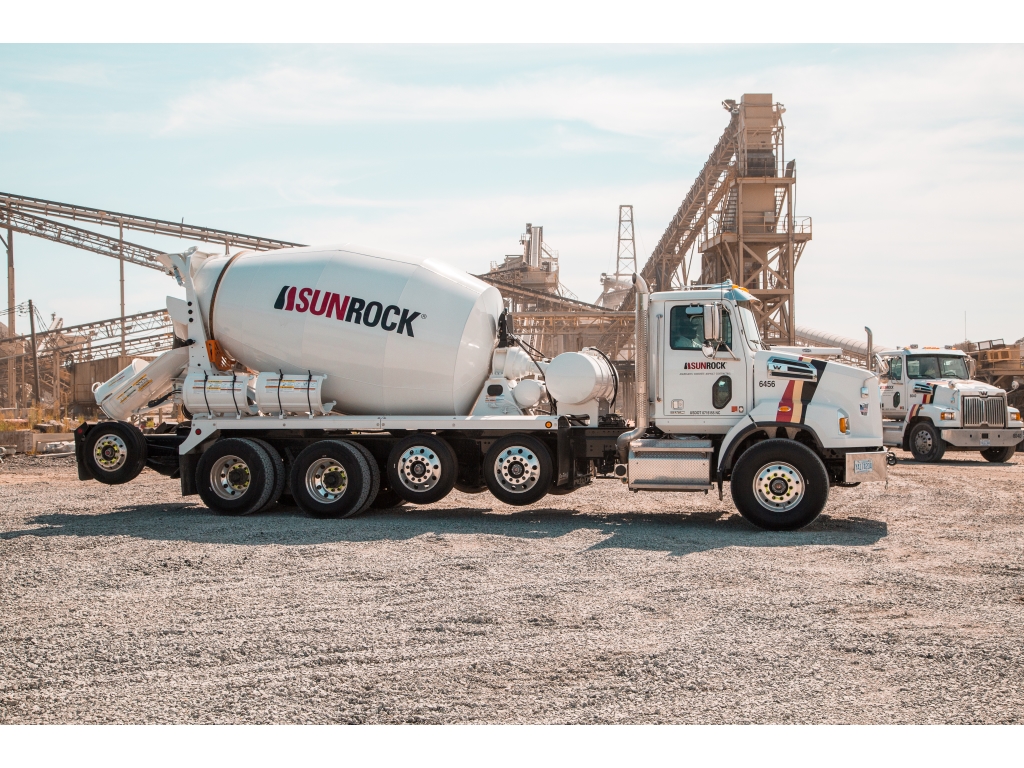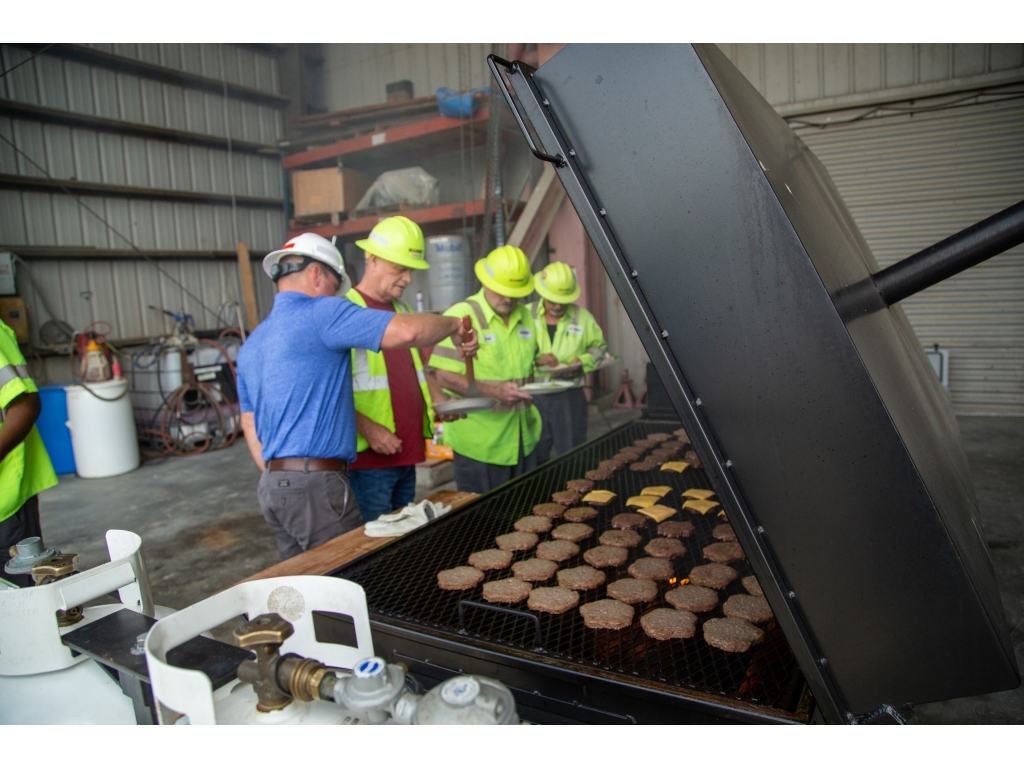
Concrete mixer truck at Butner facility Photo by Redemptive Digital
My wife and I always wanted to live out in the country, even though we both grew up in larger cities. We had the opportunity to purchase some land in Caswell County, located a half mile off a main road. During rainy weather, I got my first lesson about road maintenance, or how to have a passable road at all. I learned it takes a lot of gravel to cover a half mile of carved-out road so my vehicle wouldn’t sink down to its axles. I also learned that there are different sizes of gravel and that if you get the wrong size, it disappears! Since then, I have come to appreciate the availability and quality of rocks used for a variety of purposes on our little homestead. I was not too interested where the aggregates (rocks) came from nor the process it took to mine it until I was given the opportunity to tell a little bit of the Sunrock story in this article.
From the earliest civilizations until now, the aggregates that have been mined and the people who have engineered the cutting, shaping, and transport of the same have built structures and entire cities that have endured for hundreds and sometimes thousands of years. That story began for the Pfohl (pronounced “Fole”) brothers after World War II when Joseph, Fidelis, and Paul Pfohl began selling sand and gravel in Buffalo, NY with the formation of the Lancaster Stone Corporation.
Washed sand and gravel were literally the foundation for the Pfohl family business and America’s booming infrastructure demands. The Pfohls were innovators and offered their first “hot mix” asphalt in 1969 to service the paving needs of area cities. Composed of 95 percent crushed stones and a binder made with distilled petroleum oil, making asphalt was a logical direction for the business to take. As an aside, asphalt was not a new thing and in fact occurs naturally. It was even used by the Romans to waterproof baths and aqueducts. It has also been reported that in 1824, natural blocks of asphalt were first used for road pavement placed on the Champs-Élysées in Paris. In 1985, geologists working with the Pfohl family and in particular Brian Pfohl, son of Joseph Pfohl, recognized the growth potential in the southeast United States and identified a large, unique igneous rock deposit in Butner, NC. The growth in North Carolina, the unique durable “trap rock” deposit, and the adjacent rail line to the quarry location was the trifecta of opportunity. The Pfohls established Sunrock in 1985.

Sunrock is a mining company. According to Alex Culpepper, vice president of Corporate Business Development, Sunrock’s greatest benefit to a community is the ability to “provide high quality, low cost building materials.” The company operates multiple quarries of differing sizes and in different locations to minimize the transit time to job sites, increase efficiency, and reduce costs. Crushed stone is at the core of the Sunrock business, but in an effort to become a more vertically integrated company, offering more services to their end users, Sunrock also has asphalt, concrete, and contracting divisions.
The concrete and asphalt plants are typically located on the same sites because of the nature of the products and the materials needed to create each end-use mix. The contracting division is the fastest growing and typically works with large resurfacing, highway paving, and lane widening operations. The Butner quarry was also chosen because of the type of dark igneous rock deposit that is a harder aggregate – 8-9 on the Mohs hardness scale. With 10 being diamond, that rock is well suited for rail beds since it is durable and weathers well. (The Mohs scale is a rough measure of the resistance of a smooth surface to scratching or abrasion, expressed in terms of a scale devised in 1812 by the German mineralogist Friedrich Mohs. The Mohs hardness of a mineral is determined by observing whether its surface is scratched by a substance of known or defined hardness.)
Sunrock in Butner also sits adjacent to the The Norfolk Southern Rail line that transports thousands of tons of rock each year from North Carolina to sites along the east coast.
The size and type of rock deposits, and projected area growth are the primary factors when locating a new quarry. It is a high-risk proposition and is a multi-year process from exploration and permitting to facilities construction and finally product shipment. Sunrock understands that quarries are needed for a modern society, so when they set up quarry operations they “intend to be there for a long time, and want to be good community partners.” Mining is one of the most highly regulated industries and for good reason.
The flowchart for new mine permits and operations has no less than 24 steps that include everything from review and comment from the US Fish and Wildlife Service and the Division of Water Resources to the Division of Air Quality. It is an expensive and long-term proposition to develop a quarry location. The Woodsdale quarry in Person County and the future Caswell County quarry, both smaller than Butner, are designed to serve the needs of the power plants on Hyco and Mayo lakes as well as the growing populations in Person, northern Durham, Orange, and Alamance counties. Realistically, there is only about a 60-mile radius from a quarry to get the Sunrock products to the end users.

Concerns, especially in the rural areas adjacent to the 500 to 700 acres typically needed for a quarry operation, are always a consideration. But with mandated visual and noise buffer zones, “very strict air permits associated with dust suppression techniques,” air quality monitoring, and man-made berms around quarry operations, the actual impact of a quarry is minimal. Water requirements are indeed substantial and smaller quarries could use up to 50,000 to 100,000 gallons per day. This is why Sunrock designs quarries to use surface water and reclaimed quarry water to wash the stone, which is mandated by the North Carolina Department of Transportation before use. At the end of a quarry’s lifespan, the Sunrock plan is to repurpose the quarries as reservoirs.
No industry, whether mining or farming, can exist without water and all of us need what those industries produce. In that sense, the idea of managed growth is the key to a peaceful and mutually beneficial coexistence.
Technology is helping to make the process of producing sand, gravel, concrete, and asphalt much more efficient. In fact, asphalt is the number one recycled product by weight, worldwide. Sunrock also makes topsoil. The company’s facility in Kittrell, NC uses 45 percent mineral particles mixed with organic material to produce a balanced pH topsoil, better suited for agribusiness. In addition, companies are capturing carbon and injecting it into cement, lessening CO2 emissions. But to date, no product has been developed to substitute for crushed rock and the longevity it provides for road surfaces, construction, and the many other uses for businesses and homesteaders alike.
As Sunrock celebrates 75 years as a producer of aggregates and associated products, it continues to make substantial efforts to be a good neighbor and wants to be known as a family-owned company, based in Raleigh, that has a big stake in the success of North Carolina and Person and Caswell counties.

5280 Woodsdale Rd.
Roxboro, NC 27574
(336) 599-4147
TheSunrockGroup.com































































































